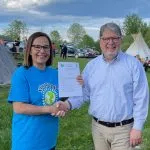
First Nation communities celebrate infrastructure investment
Several First Nations across Saskatchewan are seeing ambitious projects come to life thanks to a new infrastructure investment program from the federal government.
Kahkewistahaw First Nation (KFN), English River First Nation (ERFN), and Cowessess First Nation (CFN) have all launched unique developments as a result of a partnership with the Canada Infrastructure Bank (CIB).
CIB’s purpose is to invest in revenue-generating infrastructure which benefits Canadians, with priorities in green infrastructure, clean power, public transit, trade and transportation, and broadband infrastructure. When CIB was created five years ago, the federal government put $35 billion into the fund, with a minimum of $1 billion to be invested in Indigenous communities.
“The idea is that there are so many good infrastructure projects in our country – clean power, broadband access, water and wastewater access – all of these projects that have good economic stability and the ability to pay for themselves. But it takes a long time, and for a community to finance them on their own would mean decades of saving,” CIB CEO Ehren Cory told Eagle Feather News.

Photo supplied
“Our loans are long-term with low interest rates, and we’re willing to share risk. We have the same long-term perspective that Indigenous communities have.”
One such project is a $15.4 million investment into Kahkewistahaw Landing Infrastructure at the KFN urban reserve in Saskatoon. The project will house a medical centre, commercial units, an office centre, hotel, conference centre, industrial bays, and headquarters of the Federation of Sovereign Indigenous Nations (FSIN).
The CIB loan will mainly help water and sewer infrastructure, and roadways and sidewalks, said Chris Sicotte, Chairman of the Kahkewistahaw Economic Management Corporation.
“If we didn’t have CIB coming in to support us, it would’ve been very difficult for us to move ahead with any developments,” he said.

Photo supplied
“They offered us a very attractive financing package that will allow the nation to do this project over a period of years, and not have to worry about debt or a big repayment off the top.”
The project spans 60 acres near the airport in Saskatoon, and is estimated to take three to four years to complete, said Sicotte. KFN is the first First Nation in Saskatchewan, and the second in Canada, to receive funding through the CIB infrastructure fund.
Sicotte said he believes the project will have long-term benefits.
“Hopefully we’ll have Indigenous tradespeople during the construction phase. There will be a significant number of jobs. Then, once that is complete, there will be a lot of opportunities for employment – office spaces, the hotel and conference centre. The economic potential will be quite vast,” said Sicotte.
In another significant project in the province, CIB is partnering with ERFN and their Des Nedhe Group. A $27.3 million investment will enable a new Indigenous-owned and -operated wastewater treatment facility, as well as critical infrastructure on ERFN’s Grasswood urban reserve. The 135 acre reserve will also be home to commercial space, community gathering space, and a hotel.

Photo supplied
CIB is lending ERFN the money to get the land ready for economic development, including the wastewater facility, street building and paving,” said Cory.
“We don’t replace other forms of funding. We don’t replace treaty obligations. We don’t replace existing infrastructure, but we’re a new tool for communities for communities to borrow money in order to get things started faster, and repay us over time,” said Cory.
Additionally, CIB is partnering with Cowessess First Nation on their wind farm – a project Cory calls “incredibly ambitious and visionary”.
A recent trip to Saskatchewan from Cory and his team led to discussions with other communities and leaders about potential opportunties and investments. He said there’s a lot of interest in green power and green energy projects.
“We would love to spread the word of what we’re doing so every First Nation has the chance to think about their infrastructure needs,” he said. “And we would love to meet with as many Indigenous communities and First Nations as possible to talk about their projects.”

